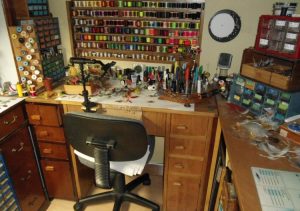Fly tying is a rewarding extension of fly fishing that lets anglers create custom flies tailored to the local waters and fish species. Not only does it save money, but it also enhances the fishing experience by offering the satisfaction of catching fish with homemade flies. To get started, beginners need a basic fly-tying kit with essential tools and materials. Here are 10 things you need to start tying your own flies for fly fishing.
1. Fly Tying Vise
A sturdy fly tying vise is arguably the most important tool for tying flies. It holds the hook securely while you attach materials to it. Look for a vise with adjustable tension and a rotating head, as these features make it easier to work on the fly from different angles.
2. Bobbin Holder
A bobbin holder is used to hold and control the thread as you wrap it around the hook. It ensures consistent tension and keeps your thread from tangling, making it an essential tool for creating clean, tight wraps on your fly patterns.
3. Scissors
Fly tying scissors are a must for cutting materials like feathers, thread, and tinsel. It’s worth investing in a quality pair that offers fine, sharp points for precise cuts. Some anglers also have a second, cheaper pair for cutting tougher materials.
4. Whip Finisher
A whip finisher is a small tool that helps tie off the thread at the end of your fly. It creates a clean, strong knot, ensuring your fly won’t come apart during use. While it may take a bit of practice to master, it’s a game-changer once you do.
5. Hackle Pliers
Hackle pliers grip delicate feathers and allow you to wind them around the hook easily. This is particularly important for tying dry flies, where feather hackles create the fly’s buoyant body.

6. Thread
Fly tying thread is available in various colors and thicknesses. Depending on the type of fly you’re tying, you’ll need a range of threads. Thinner thread works well for delicate flies, while thicker thread is more durable and better suited for larger flies.
7. Feathers and Hackle
Feathers are a fundamental material in fly tying, used to create wings, tails, and bodies. Hackles, which come from birds like chickens and roosters, are popular for dry flies because they help the fly float. Ensure you have a variety of feather sizes and colors for different fly patterns.
8. Hooks
A wide range of hook sizes and shapes is needed to tie different types of flies, from tiny midges to larger streamers. Make sure to buy hooks specifically designed for fly tying, as they’re typically barbless or have minimal barbs, which helps with better presentation and catch-and-release practices.
9. Dubbing
Dubbing is a fine, synthetic or natural material that is wrapped around the hook to create the body of a fly. It adds texture and weight to the fly, imitating the natural body of insects or bait. Dubbing can be purchased in various colors and materials to match the local fishery’s hatch.
10. Head Cement
Once your fly is tied, head cement is used to secure the knots and give the fly extra durability. It’s applied to the thread head to prevent unraveling. Some fly tiers prefer a UV-cured resin for added durability and quicker drying times.
Tying your own flies requires an initial investment in tools and materials, but it’s a highly rewarding skill that deepens your connection with the sport of fly fishing. Start with these 10 essential items, and as you gain experience, expand your fly tying materials to craft more complex and customized patterns. Whether you’re looking to imitate local insects or experiment with new patterns, tying your own flies allows for endless creativity and customization.
Image: TheWickedFly





